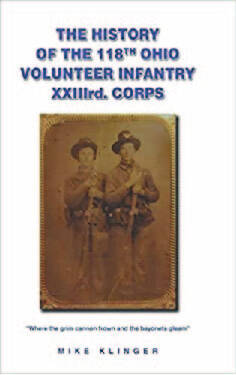
SIDNEY — A new book telling the stories of the men who served in the 118th Ohio Volunteer Infantry during the American Civil War has been roughly 50 years in the making.
“When I was in high school, I realized I had two ancestors in the Delphos company. I discovered two Klingers in the Delphos company. I drove over to my grandpa’s to ask him who they were, and they were his grandpa and his great uncle. I was off, and I’ve been collecting this regiment since high school,” Michael Klinger said.
Klinger grew up in Delphos, and recalls walking past the Civil War Monument every day on his way home from school. He used to stand and look at it, and one day, he realized that the soldier depicted in the monument did not look victorious — he looked tired, and looked like he was leaning on his musket.
“I remember thinking, ‘that’s probably what it was like,’” Klinger said.
His new book, “The History of the 118th Ohio Volunteer Infantry XXIIIrd. Corps,”reflects much of the story that monument told Klinger so many years before. The book is based off of 500 letters, six diaries and the regimental surgeon’s day book, all of which has been gathered by Klinger for more than five decades in his quest to learn more about the men who served in the 118th Ohio Volunteer Infantry. Of roughly 1,000 men who served, more than 30 came from Sidney.
“This book has 323 pages of text in it, 485 pages total because I put the roster in there, the index and an extensive bibliography. My hope is that, not only will it be a good read, but it will become a primary resource for people doing articles or writing on the campaigns this unit served in,” Klinger said.
The most surprising thing Klinger learned during his time collecting information and writing, he said, was how sick the healthy soldiers were. With experience as a critical care nurse and an army medic, the surgeon’s day book intrigued him the most.
“I found an estimate that at the start of the Atlanta Campaign, they estimated that half of Sherman’s men had Malaria. Within one month, half of them also had scurvy. These guys were fighting sick on their feet,” Klinger said. “I mentioned something about them being on one-fourth to one-half rations each month. These guys were starved, and they were still fighting.”
A large focus Klinger put on the book was illustrating the soldier’s daily struggle for survival. Outside of a battering of hunger and exposure, he said there was a constant drumbeat of death on the men fighting. Whenever a soldier died, be it from injuries sustained in battle, hunger or disease, Klinger made sure to highlight that in its own sentence.
“As you’re reading, it hits you like a drumbeat that these guys, every other day, were getting news that somebody else died, or somebody else was disabled, or somebody else was killed or wounded. They started the war with about a thousand men, and at one point, the regiment was down to 120 men,” Klinger said.
Klinger hopes that the main takeaway readers get from the book is, what these men from across local townships, cities and counties did for their country. He also hopes they find out the wide variety of reasons each man fought in the war and served in the infantry. Ultimately, he hopes that he’s done a good job of telling the stories of the men who served in the infantry during a turning point in American history.
“It’s been a long journey, and I kept one thing in the back of my mind: I always thought, if there’s an afterlife, and I meet these guys, I hope they’re pleased with what I did,” Klinger said.
“The History of the 118th Ohio Volunteer Infantry XXIIIrd. Corps” can be found at Barnes & Noble and on Amazon.com.


